Humidity and temperature variations in buildings - also known as hygro-thermal changes - are well known among building professionals. Heating creates evaporation, while cooling often results in condensation. Because air always contains quite significant amounts of humidity in vapor form temperature and humidity changes are inseparable.
What is less known: there is a third important variable just as closely connected to humidity as temperature - the electrical charge. Various electrical aspects of evaporation, diffusion and condensation are well known in other branches of Engineering and Technology, but virtually unknown to building sciences.
Charge Transport in Water
Individual water molecules are connected via hydrogen bonds.
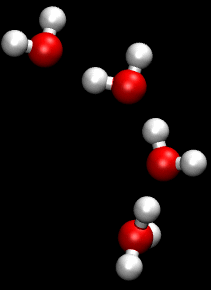
Proton (H+) hopping in water
Hydrogen bonds are not "true" intermolecular bonds, but very weak electrostatic attractions between slightly positive hydrogen (H+) and slightly negative oxygen ions (O2-). Being so weak, they form, break and reform easily. They are dynamic (flickering) bonds lasting only picoseconds, water molecules constantly forming new connections with neighboring (random) molecules.
As a result, water molecules don't have a fixed structure. During the making and breaking of hydrogen bonds, H⁺ ions are transferred between water molecules in a complex manner, resulting in a mix of H2O, H3O+, OH− and H+ ions in water.
The fast movement of H+ ions (protons) between neighboring oxygen atoms, known as proton hopping or jumping, is an important charge-transfer pathway - known for 200 years.
Hopping H+ ions (protons) move twice as fast as OH− (hydroxide) ions, 4X faster as H2O (water) molecules and 7X faster than dissolved salt (Na+ or K+) ions. giving water some very unique properties.
Let's look at some of the electrical aspects of well-known water transport mechanisms.
Evaporation
An important source of moisture for masonry are the evaporating water vapours from the environment, which can significantly contribute to the wetting of masonry,
The surface of liquid water, in contact with the air, forms an electrical double layer, a special molecular arrangement carrying an electrical surface charge. During evaporation, while tiny water droplets detach from the surface, the fast mobile H+ ions (protons) "jump" through the charged surface layer, giving the electrified vapour cloud above the surface a positive charge. 1Shavlov, Anatoly & Dzhumandzhi, V.A. & Yakovenko, A.A.. (2018). Charge of Water Droplets during Evaporation and Condensation. Journal of Aerosol Science. 123.10.1016/j.jaerosci.2018.05.016.
Our findings confirm the same thing: water vapours during evaporation always carry a positive charge. The accumulated charge can be measured with a multimeter between two points of the masonry, showing up as a DC voltage of up to a few hundred milivolts.
Conversely, positive or increasing electrical voltages in damp masonry always indicate an increase of vapour content as a result of evaporation - a sign that the wall fabric is drying out.
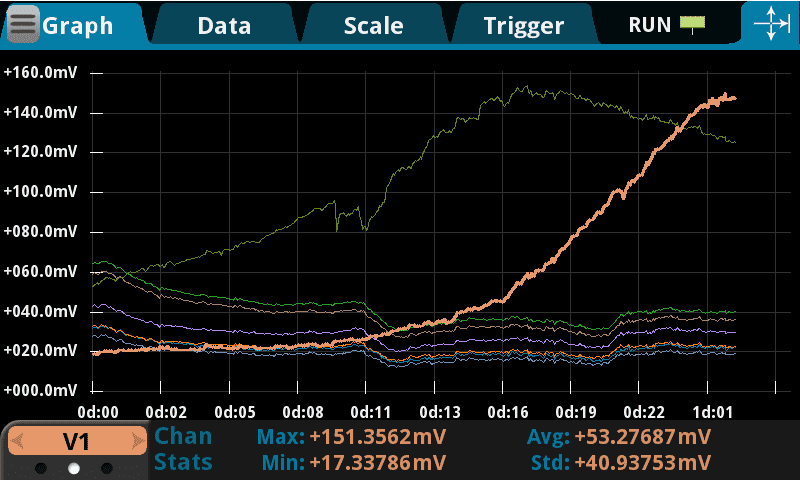
Evaporation driven DC voltage increase in damp masonry (V1), indicating that the masonry is drying out
Natural evaporation is a slow process. As you can see above, in the absence of explicit heating it took over 14 hours for the voltage (V1) to climb from 20 mV to 150 mV.
Heating: our experimental results indicate that 90 minutes of heating created a much more significant impact onto the masonry than half a day of natural evaporation. Here we used 5 measurment points. Initially, all 5 voltages have dropped sharply, indicating the occurrance of condensation - warm air condensing on cold brick surfaces. However, after a few minutes, once the masonry started to warm up, evaporation kicked in and all voltages started to increase quickly.
What we can observe here:
- Top of the test wall: V5 (green line): being the driest, furthest away from the soil, here evaporation is most pronounced. Electrically charged water vapors manifest as a positive voltage in the wall fabric.
- Bottom of the wall: V1 (red line): the bottom of the wall is the dampest, liquid moisture transport mechanisms dominating. With very little vapors present, the electric potential is the lowest here.
- In between the top and bottom: we have another 3 interim measurment points (V2, V3 and V4). The further these are from the damp ground, the drier the masonry, the more evaporation, the higher the voltage inside the wall fabric.
- This experiment also shows that the voltage in the masonry is a direct indicator of the moisture content of the wall fabric.
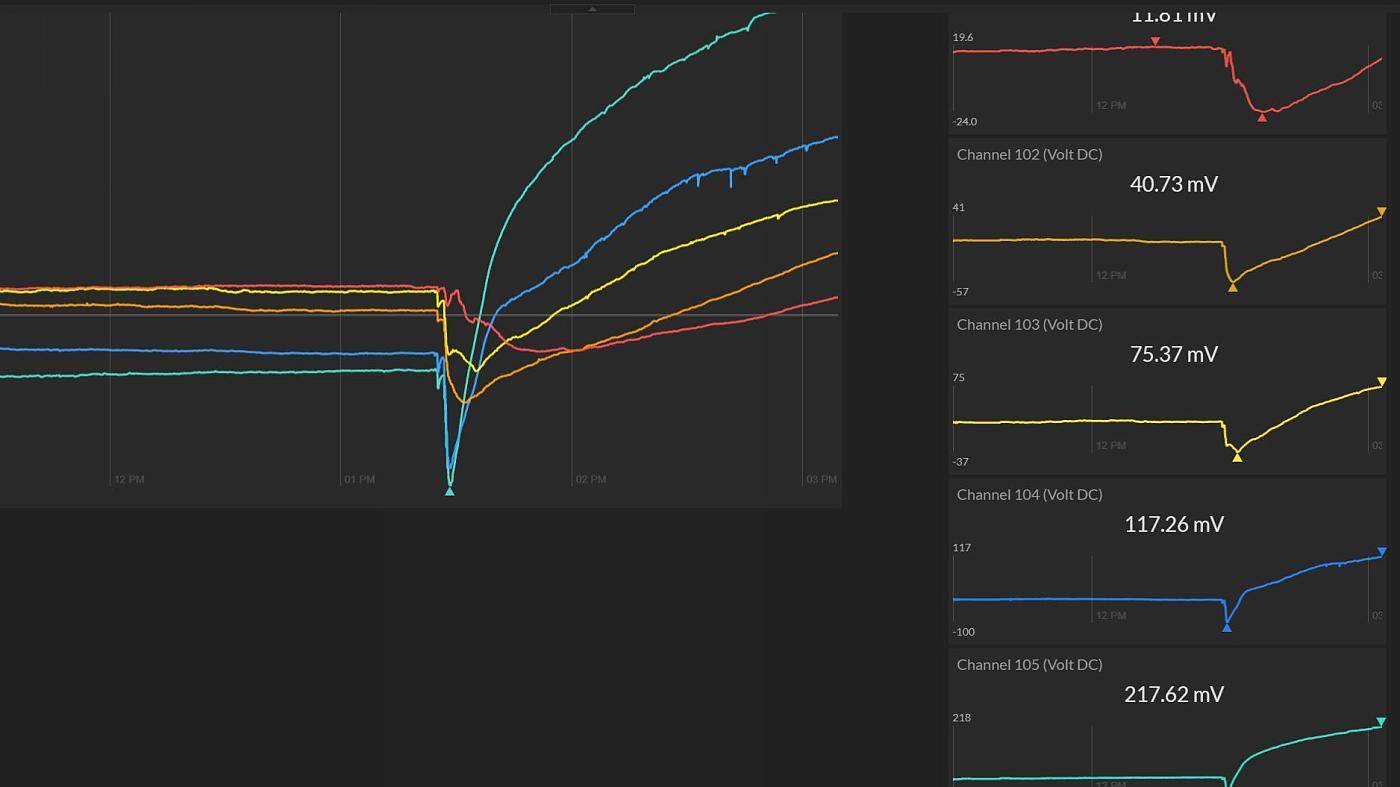
Heated masonry. Heating creates froced evaporation, which drives the electric potential up
Diffusion
The evaporated water cloud from the soil migrates upwards through the capillaries. Some of this water gets deposited onto capillary walls, commencing the wetting of masonry.
The wetting cycle of dry masonry starts with the formation of a single layer of water on the capillary walls 2Köfinger, Jürgen & Hummer, Gerhard & Dellago, Christoph. (2011). Single-file water in nanopores. Physical chemistry chemical physics : PCCP. 13. 15403-17. 10.1039/c1cp21086f. (monolayer adsorption). As a special case, in very narrow nano-capillaries water forms long chains of water wires, held together by tight hydrogen bonds.
These thin, weak monolayer water structures having no depth, are particularly sensitive to electric field variations, which can disrupt the hydrogen bond network, generating defects, perturbing the proton (H+ ion) transport.
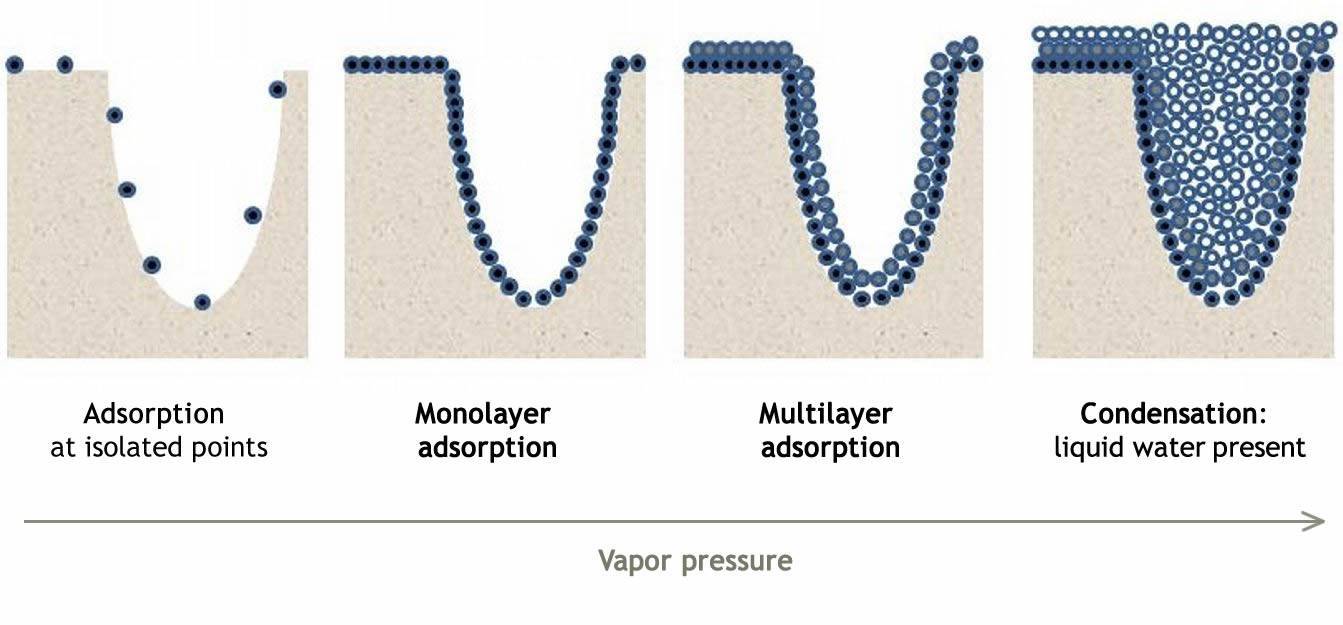
Various phases of adsorption on a capillary wall
Condensation
More and more diffusion leads to the appearance of liquid water on the capillary walls, resulting in internal or interstitial condensation.
Condensation is the reverse phenomenon of evaporation. From electrical standpoint, condensation too is accompanied by very specific electrical phenomena. During condensation the positively charged water vapors move back into the bulk water, charging the surface positively and the vapour negatively, This shows up as a voltage drop in the masonry.
Voltage drops in masonry indicate condensation.
Depending on how intense the condensation is, the accompanying voltage drop can be very sharp or mild. Following the abundant wetting of a completely dry brick in our lab, the gradual moisture build-up is followed by an in intense, sudden condensation - marked by a large, almost vertical voltage drop - as shown below.
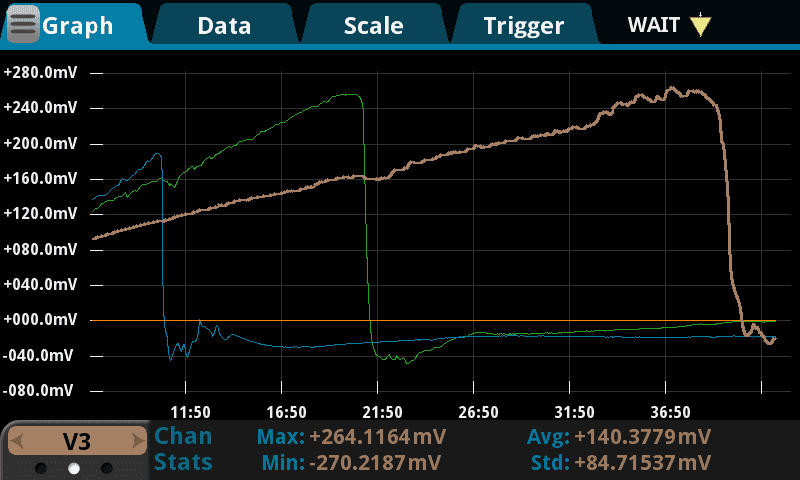
Condensation appears as a sudden voltage drop when the evaporated cloud loses its charge
The extent of condensation depends on the balance of adhesion forces between water molecules and the surface, and the intensity of electric / magnetic fields from the environment.
Water molecules being polar, external electric and magnetic fields can significantly affect the properties of water, especially of thin films, including its wetting and adherence to solid surfaces. Electric fields for e.g. can rotate water molecules preventing them from coming into contact with the surface, slowing down or restricting condensation altogether. 3Wang, Qin & Xie, Hui & Hu, Zhiming. (2019). The Impact of the Electric Field on Surface Condensation of Water Vapor: Insight from Molecular Dynamics Simulation. Nanomaterials. 9. 64. 10.3390/nano9010064.
Electro-Hygro-Thermal Framework
The masonry is never in a static equilibrium condition but in constant change, undergoing successive wetting-and-drying or condensation-evaporation cycles.
These cycles are influenced by a multitude of variables, some known, some less known - including temperature and humidity differences, porosity and pore geometry, intermolecular forces, electrochemical effects (e.g. salts), surrounding electric and magnetic fields etc. etc. just to name a few - which all effect the masonry in some way. Some of these variables facilitate drying, others facilitate wetting - and the net combined effect of these determines whether the masonry is getting drier or damper in the long-run.
These individual variables are also not constant, but undergo seasonal (e.g. summer-winter driven) or one-way (e.g. aging or getting-worse-in-time type) variations, so their net combined affect in time is also changing constantly. This explains some of the successive improvement and deterioration cycles (e.g. a building getting dryer during summer and wetter during winter), or time-delayed effects (e.g. problems suddenly appearing after X amount of years) old building owners are so familiar with.
These successive condensation-evaporation or wetting-drying "microcycles" are closely mirrored by corresponding electrical changes in masonry - voltage and current increases and decreases - which provide accurate and reliable diagnosis information about the current wetting state of masonry - supplementing any hygro-thermal data collected. Thus the electro-hygro-thermal parameters together better describe the moisture content of the masonry than hydro-thermal variables alone.
Conclusions
- Hygro-thermal changes in masonry are accompanied by a suite of electrical changes - well known in other technological fields but largely unknown to building sciences.
- The movement of water in porous masonry through various water transport mechanisms - including diffusion, condensation and evaporation - are accompanied by very specific electrical effects.
- Evaporation is always accompanied by a positively charged vapour cloud due to proton (H+) hopping, which brings about an increased electrical voltage in masonry.
- Condensation is denoted by the appearance of liquid moisture on capillary walls. This is accompanied by a decreasing negative vapour cloud and a dropping electrical potential in the wall fabric.
- Water being polar in nature, external electric and magnetic fields can influence the wetting capability and adherence of water to solid surfaces. The presence of certain fields can decrease or restrict condensation and the continuous re-wetting of masonry.
- The electro-hygro-thermal framework better describes the behaviour of water inside porous materials than hydro-thermal framework alone. The additional electrical variables provide accurate and reliable diagnosis information about the movement of moisture and the current wetting state of masonry.
Next, let's look at a typical wetting-drying cycle in more detail.
References
| 1 | Shavlov, Anatoly & Dzhumandzhi, V.A. & Yakovenko, A.A.. (2018). Charge of Water Droplets during Evaporation and Condensation. Journal of Aerosol Science. 123.10.1016/j.jaerosci.2018.05.016. |
|---|---|
| 2 | Köfinger, Jürgen & Hummer, Gerhard & Dellago, Christoph. (2011). Single-file water in nanopores. Physical chemistry chemical physics : PCCP. 13. 15403-17. 10.1039/c1cp21086f. |
| 3 | Wang, Qin & Xie, Hui & Hu, Zhiming. (2019). The Impact of the Electric Field on Surface Condensation of Water Vapor: Insight from Molecular Dynamics Simulation. Nanomaterials. 9. 64. 10.3390/nano9010064. |





